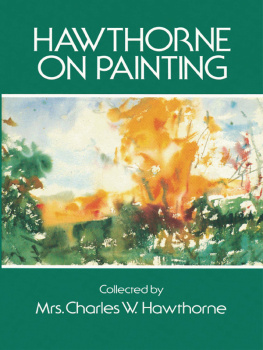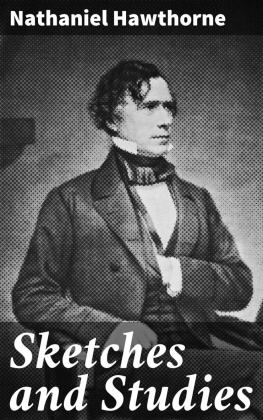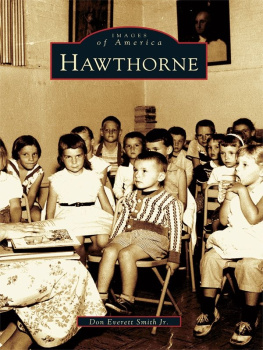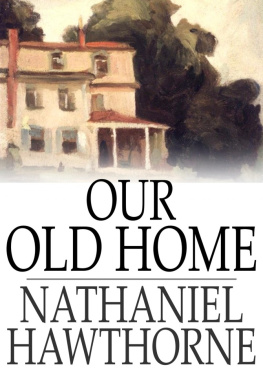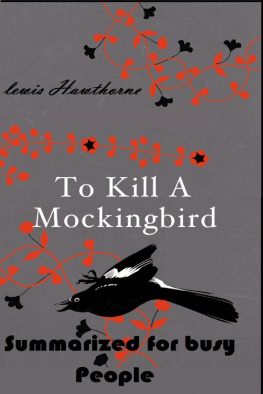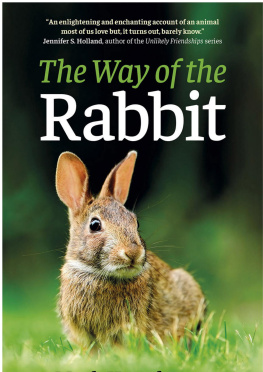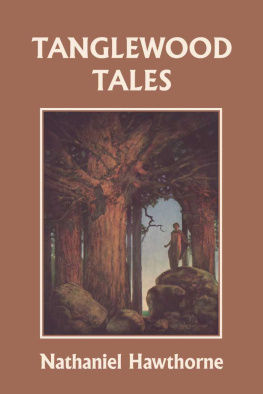This edition is dedicated
to the memory of
Charles Webster Hawthorne
1872-193
Hawthorne
on Painting
From Students Notes Collected by
MRS. CHARLES W. HAWTHORNE
With an Introduction by
EDWIN DICKINSON
and an Appreciation by
HANS HOFMANN
DOVER PUBLICATIONS, INC.
NEW YORK
Copyright 1938 by J. C. Hawthorne; Copyright renewed 1965 by J. C. Hawthorne.
Copyright 1960 by Dover Publications, Inc.
All rights reserved.
This Dover edition, first published in 1960, is an enlarged republication of the work published by the Pitman Publishing Corporation in 1938.
Library of Congress Catalog Card Number: 60-50099
International Standard Book Number
ISBN-13: 978-0-486-20653-0
ISBN-10: 0-486-20653-X
Manufactured in the United States by Courier Corporation
20653X27
www.doverpublications.com
FOREWORD TO DOVER EDITION
The first edition of this book was published in 1938 by the Pitman Publishing Corporation. The chief architects, so to speak, in fashioning the book out of the tremendous volume of notes sent in, were my mother, herself a painter of ability, and Miss Margery Ryerson, a talented student of my father.
I quote the pertinent sections of the Foreword to the first edition, which was signed by my mother, Miss Ryerson, and myself:
This volume is the essence of notes taken by students of the Cape Cod School of Art through thirty-one years of the schools existence. Notes from all parts of the continent said substantially the same thing, so there can be little doubt of authenticity. It had long been Mr. Hawthornes intention to write a book for students and young painters and this attempts to carry out his idea, keeping the feeling of the spoken words the notes are better read aloud.
The text of my fathers Notes has not been abridged or altered for this edition. However, the color plates which appeared in the 1938 edition have been dropped because, with the great reduction in size that was necessary (the studies were 25 x 30), they did not successfully represent my fathers work. The introductory essays to the first edition by Royal Cortissoz and Stephen Gilman are also not reprinted.
I should like to thank two great painters and teachers for their contributions to this book: Edwin Dickinson for writing the Introduction, and Hans Hofmann for permission to reprint his Hawthornethe Painter, an appreciation which first appeared in the catalogue of the memorial exhibit of my fathers paintings at the Provincetown Art Association in the summer of 1952. Lastly, I should like to thank Miss Margery Ryerson, whose help in all departments in preparing this edition was indispensable.
| Toledo, Ohio | J.H. |
| November, 1959 |
That plane relationships are more representable through comparative value than through implications of contour drawing was a truth which Mr. Hawthorne drilled into his pupils. I think no other teacher gave the importance to it that he did. His pupils, in their best color, being required to practice it daily, were able to understand it and, in time, to quite well perform it. It freed far more people than it bound.
In the life class, in striking through contour and mass, his counsel was always broad; he never referred to small miscalculations or omissions, and every imperfectness was at once pointed out in reference to elements as large as general character, color, or posture.
Good brushwork was quickly put in its place, and acceptableness of surface depended entirely upon color constitution.
His exceptional power as a demonstrator further increased his students realization of the gulf which separated them from a master. Though Mr. Chase, his master, was a famous and beautiful demonstrator, Mr. Hawthorne surpassed him. Seen by us during the rest, the perfectness of his first spots, coupled with the delighting surprise that they could be stated that way, made us readier than before to give his advice the almost implicit trust which paved the way to our learning the basic principles he gave us.
Our belief that we were learning important things created an atmosphere of security and hope. In retrospect, this belief is even more firmly held.
| New York | EDWIN DICKINSON |
| November, 1959 |
Although the great art revolution in France was well under way fifty years ago, the spread of its rediscovered pictorial tradition was largely confined to Paris. Elsewhere, the visual arts were in a state of steady decline since the inventions of the Baroque. Had not this vacuum from time to time been filled by the cometlike appearance of several extraordinary painters, the period would have passed without leaving any vital pictorial documentation of it. These artists were great on the basis of the human quality which they had to offer and which is reflected in their work. They were true painters in spite of their lack of tradition by virtue of their sensing the miraculous qualities of the medium through which they communicated. They painted the world in which they lived and this world nourished their soul and developed their sensibility. Their time did not understand itit did not even considerthe cultural and ethical mission demanded of the arts; if not for the creative urge inborn in Man to glorify the human spirit, it would have been without any ethical or cultural justification.
France alone held to a steady and purely painterly tradition: Gricault, Delacroix, Corot, Courbetthen Manetand from there, in a straight line to our day. Outside of France, it was spasmodic. Best in Germany, the romantic Spitzweg, Leibl, Hans van Mares and Corinth, followed later by Ensor in Belgium, Munch in Norway and Mancini in Italyall isolated figures. That America produced Whistler, Ryder, and more recently, Maurer and Arthur Carles is especially worthy of notice. It is with these that Hawthorne belongs. The concept of his art rooted deeply in American life; it is among these painters that his best work takes its place.
It has been said, adversely, that his technique and means of expression were borrowed from the old masters. This is shallow criticism. He is not an eclectic; it is rather that in struggle for a universal painting expression, he allied himself strongly with the only tradition that he felt.
His pictures do not have that esthetic charm so much demanded today by anemic hypersensitives. His painting is the antithesis of the prevailing misconception that admires taste and design. Taste is not a creative faculty. It is more important that Hawthornes work is robust and provocative, that it gives evidence of an abundant, vigorous mind, of a cataclysmic temperament. As a painter, he cast aside every doctrineso that he might surpass the limitations of calculation and construction. Art must surpass such limitations.
When, in certain works, the demands of creative dimension overreached capability, it is to detailsa fish, a basket, a head in profile that we must look for realization. But, when successful, his work carries the entire signature of the great artist. Painting rises out of the volcanic center of the artists temperament. Compared to this, estheticism is only shadow.
When artists again became aware of the reality of spatial and formal relationship, cubismanalytical and syntheticcame into existence. But painting also asks for simultaneous consideration of the inherent quality of the colors as a creative means. It is in the realm of this reality that color must function. The painter of today is concerned with its re-evaluation as a plastic means. Both form and color have their own intrinsic laws; composition must be dominated by the dictates of both. Thisonly thisis painting. Mastered in this way, painting will have a mysterious and magic appeal. Mastery means the creation of a richly orchestrated pictorial space in which form, fusing with color, turns into a new realitythe created painting. The art of pictorial creation is indeed so complicatedit is so astronomical in its possibilities of relation and combinationthat it would require an act of superhuman concentration to explain the final realization. Such an awareness is usually absent in the artist. He will never be able to explain the full process which led to his creations. But what Hawthorne as a painter aimed for and gave by intuition has become today a conscious tool of his successors.
Next page
